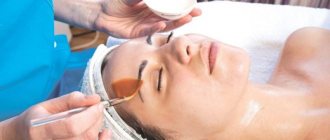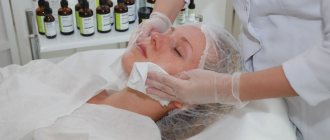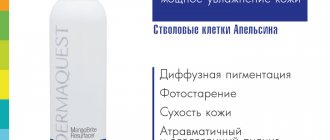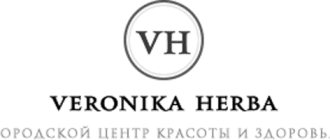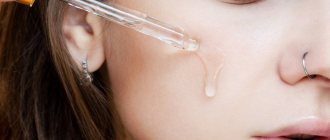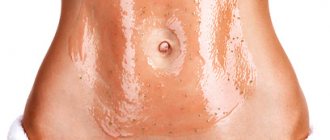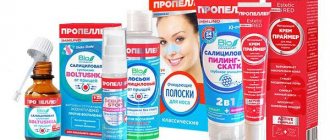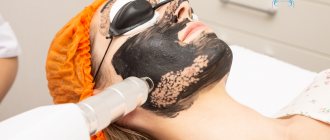Each of us, sooner or later, thinks about the possibility of rejuvenating our face in such a way that the image in the mirror looks several years younger and makes us happy not for a few weeks, but preferably for a couple or even more years. Many people believe that this can only be achieved through plastic surgery. Of course, if the case is advanced and there is severe tissue ptosis, we will not dispute this.
But if everything is not so “tragic” and you don’t want to lie down on the operating table, then modern laser systems are at your service, which have reached such a development that after several laser peeling procedures, the skin begins to look several years younger.
A short, concentrated beam of light is directed onto the skin. When laser skin resurfacing, it is removed very precisely, layer by layer. This popular procedure is known by another name - laser peeling or laser evaporation of tissue.
Who should undergo laser skin resurfacing?
If you have minor wrinkles around the eyes, mouth or forehead, acne scars, or unresponsive skin after a facelift, then laser skin resurfacing may be the answer for you. Among the ways to combat purse-string wrinkles, laser resurfacing has no equal. It is worth noting the excellent results of laser resurfacing of the upper and lower eyelids - the so-called non-surgical blepharoplasty.
Contraindications to the laser resurfacing procedure:
- Any inflammatory processes on the skin;
- Chronic diseases in the phase of exacerbation and decompensation;
- Infectious and viral diseases, including herpes infection;
- Pregnancy and lactation;
- Diabetes;
- Tuberculosis;
- Epilepsy;
- Disturbances in the blood coagulation system;
- Tendency to form culoid scars;
- Acne during the period of exacerbation;
- Presence of a pacemaker;
- Period of menstruation;
- IV skin phototype according to Fitzpatrick.
Types of laser peeling for the face for wrinkles and other skin problems
- Cold laser peeling
This is what is commonly called superficial laser peeling, which does not heat the deep layers of the epidermis and does not affect the dermis. It evens out skin texture and tone well. After a course of superficial peeling, she looks smooth and radiant - the effect of the procedure is similar to acid peeling, which visually rejuvenates the face.
Before the procedure, local anesthesia is required (a special anesthetic cream is applied to the skin). Complete exfoliation occurs in 2–3 days. There is no severe swelling.
- Hot laser peeling
The technique involves influencing at a deeper level, which also affects the effect - it is more pronounced and comparable to medium acid peeling.
Deep laser peeling can be carried out with different types of devices - fractional and standard. The second type is more traumatic; in this case, the laser beam damages the entire skin, making several passes and evaporating the epidermis layer by layer. The dermal layer also warms up, which helps stimulate the production of protein structures.
A deeper effect on the skin makes the painful sensations stronger. Rehabilitation is not quick or easy. Swelling persists for several days, the face is covered with crusts that disappear for at least a week. But after healing, the rejuvenating effect is impressive: the skin texture is evened out, it is noticeably tightened, it becomes more elastic and firm.
- Fractional laser peeling
This procedure is much easier to tolerate than the previous one, and recovery after it is easier, because during laser exposure the skin is not completely damaged. Between the areas heated by the laser, there are microscopic zones that are not affected by the laser. Fractional laser peeling can be either cold or hot - the method allows for exposure at different levels.
You can also find another name for this peeling – laser photothermolysis. The advantage of a fractional laser compared to a traditional one is its targeted effect. During photothermolysis, the laser beam breaks up into a mass of very thin beams. The impact on the skin occurs from the superficial to deep layers. Nevertheless, the tissues are damaged fragmentarily and in doses, and there are untouched gaps between the injured areas, so rehabilitation does not take much time and causes virtually no discomfort. The procedure itself does not cause pain either.
It takes about five days for the microscopic crusts to disappear. You can see the result within a week. And although many are satisfied with the effect after the first procedure, it is recommended to complete a course (3-4 sessions) so that the skin is completely renewed.
Recommended articles on the topic:
- Ultrasonic facial peeling is a pleasant and beneficial procedure for your skin
- Redermalization of the skin: all the pros and cons
- Almond peeling for the face: features of the procedure
- Carbon laser peeling
Laser carbon peeling is a new procedure, it is aimed at deep cleansing the skin, is effective and painless. In another way, this peeling is called carbon cleaning. It is used if the skin is acne-prone or too oily. At the first stage, a mask with carbon dioxide (CO2) is applied to the face; laser peeling is done directly at the second stage, when the mask has dried.
Laser resurfacing with erbium
In our center we use an erbium laser for skin resurfacing (Multiline laser complex)
Erbium laser resurfacing is designed to remove superficial and medium-deep wrinkles on the face, arms, neck or chest. One of the advantages of erbium laser resurfacing is minimal burn of surrounding tissue. This type of laser causes minimal side effects such as swelling, bruising and redness, so recovery time is shorter than with CO2 laser resurfacing.
Laser resurfacing with erbium in our center is carried out on an outpatient basis, using local anesthesia (pain relief at the procedure site), in combination with oral sedatives. Wrinkles around the eyes, mouth or forehead can be treated individually, or the entire face can be treated with laser treatment. Partial facial laser resurfacing takes 30-45 minutes, while the full face treatment lasts 1-1/2 to 2 hours.
With superficial and medium laser peeling, the recovery period lasts approximately 7-10 days . With deep laser resurfacing - up to 3-4-6 months . During the recovery period there is no need to be in hospital if there are no prerequisites for this in the form of complications. After laser peeling you can get the following:
- Younger and firmer skin;
- Improved blood circulation and complexion;
- Reduction or complete removal of wrinkles;
- Tightened facial contour;
- Elimination of minor skin defects;
- Reducing the size and visibility of deep scars, stagnant spots, including post-acne marks.
The full results of deep laser peeling can be assessed after 4-6 months, but at the same time they can please you for several years.
Indications for laser peeling
The essence of the hardware technique, called laser peeling (resurfacing, dermabrasion), is that under the influence of a laser beam, controlled damage to the epidermis occurs in order to start the process of skin renewal. During the procedure, due to the strong heating of the skin surface, some of its layers evaporate.
Laser peeling is a professional cosmetic procedure that gives a noticeable effect in the fight against imperfections and skin problems that are much worse dealt with by other methods. The face literally transforms after laser peeling. Moreover, the depth of exposure can be adjusted, focusing on the severity of skin flaws and their localization.
Using this procedure you can get rid of:
- scars and stagnant spots formed due to acne;
- scars and stretch marks (all over the body);
- sagging facial skin and wrinkles on it;
- sagging and thinning of the skin of the eyelids.
Laser peeling will be useful in the following cases:
- uneven skin texture;
- there are pigment spots on the face;
- too enlarged pores on the skin;
- dull complexion, lack of skin tone;
- there are milia;
- hyperkeratosis is observed.
Price for services
| LASER COMPLEX MULTILINE, ERB | |||
| № | Name | Duration | price, rub. |
| 1 | Full face | 60-90 min | 15000 |
| 2 | Forehead | 30 min | 5000 |
| 3 | Cheeks | 30 min | 5000 |
| 4 | Chin | 30 min | 5000 |
| 5 | Upper lip | 30 min | 5000 |
| 6 | Laser blepharoplasty (upper and lower eyelids) | 30 min | 8000 |
| 7 | Neck | 30 min | 5000 |
| 8 | Face + neck | 60 min | 17000 |
| 9 | Cleavage | 30 min | 7000 |
| 10 | Face + neck + décolleté | 60 min | 20000 |
| 11 | Hands | 30 min | 5000 |
| 12 | 1 sq. cm | 10 min | 500 |
Skin care after laser peeling
At the end of the procedure, the skin looks inflamed: it becomes red, serous fluid is released and the surface temperature of the tissue increases. As a result of laser exposure, brown spots and red dots often appear on the face. During the first day, swelling increases, wrinkles, scars and other skin imperfections become more noticeable.
Over the course of the next week, crusts will form on the skin. They need to be looked after properly. In about two weeks, the injured tissue will heal. Although the redness will remain for about the same time. The result of laser peeling depends on the type of treatment and the patient’s lifestyle. The duration of the effect is from 6 months to 1 year.
How to care for your skin during the rehabilitation period:
- if the laser peeling was deep, it is necessary to apply sterile gauze bandages or meshes soaked in Vaseline; the bandages must be changed every 3 hours;
- to reduce swelling, ice wrapped in a cloth or cold packs should be applied over the bandage several times a day;
- to soften the crusts and get rid of the ichor, apply napkins soaked in a vinegar solution (1 glass of water, 1 tablespoon of white vinegar) to the skin for 5 minutes; the need for the procedure disappears after the wounds stop bleeding and the crusts come off easily;
- after compresses, the skin surface should be treated with Chlorhexidine solution; it is forbidden to wash your face with cosmetic gels, foams, etc.;
- to get rid of pain, they take Tempalgin and similar drugs; often, in order to prevent complications, doctors prescribe broad-spectrum antibacterial agents, the course of such therapy is up to 10 days;
- for sleeping, it is recommended to use a high pillow, so that the head and upper chest are higher than the rest of the body; sleeping is only allowed on the back;
- During the first week after laser peeling, it is forbidden to rub your face, apply makeup, or use care cosmetics that contain aggressive components; if possible, it is better to stay at home;
- in the second week you can go outside, but first apply sunscreen moisturizer to your skin;
- after 3–4 weeks, it is recommended to visit a cosmetologist who will evaluate the effect of the procedure; at this time, you can enhance the result with biorevitalization or mesotherapy and set a date for the next laser peeling session;
- until the course of procedures has been completed, and for another 2 months after the final one, it is recommended to refrain from tanning.
Those who decide to undergo a laser peeling course should be prepared for such consequences as prolonged rehabilitation and discomfort during the recovery period. But these unpleasant moments are quickly forgotten when the effect of the procedure is fully manifested.
To consolidate the result, you can additionally carry out ozone therapy, plasma lifting, and mesotherapy.
Frequently asked questions about the laser peeling procedure
How many times should laser peeling be done?
To obtain a lasting effect, a course of procedures (from 2 to 8) is recommended. The interval between them is usually one to two months.
What is the price of laser facial peeling?
The cost of the service is determined depending on factors such as the depth of penetration of laser energy, the area of impact, the functionality of the equipment, the use of anesthetics and additional cosmetics. Different types of peeling can cost from 5 thousand rubles to 40 thousand. The most expensive procedure is one that includes treatment of the face and décolleté. The cosmetologist can make a specific calculation after the therapy program has been determined.
Recommendations before and after cleaning
2 weeks before the procedure, it is necessary to protect your facial skin from direct sunlight: avoid solariums, go to the beach, use products with SPF in accordance with the intensity of sun exposure. Also, do not resort to chemical peels. 3 days before the session it is better not to visit baths and saunas. It is better to visit a cosmetologist without decorative cosmetics.
After the procedure, redness may persist for up to 24 hours. It depends on the sensitivity of the skin and individual health conditions. However, in general, the recovery period is at least 5 days, even in cases where the skin looks as usual. Recovery time depends on the depth and intensity of exposure, existing skin problems, individual regenerative ability, and age.
During the first 24 hours, it is better not to wet your face and refuse to use decorative cosmetics. In the future, it is preferable to use thermal or micellar water for washing - the doctor will give specific recommendations if necessary.
For 2-3 days you should use cosmetics recommended by a cosmetologist.
It is also important to follow a diet, this is especially true for patients prone to food allergies. You need to exclude sweets, brightly colored vegetables and fruits, alcohol, marinades, and smoked foods from your diet.
How it goes
- The fractional laser peeling procedure is performed using an anesthetic cream.
- After a preliminary conversation with the patient about existing problems and studying the characteristics of his skin, the doctor performs makeup removal.
- An anesthetic is applied to cleansed skin and left for 40-60 minutes.
- The patient protects his eyes with glasses.
- The doctor selects the laser exposure parameters, removes the anesthetic, applies a lubricating cream and begins Fraxel peeling.
- When the manipulator touches the skin, fractional destruction of defective cells occurs, the patient feels warmth and a slight burning sensation.
- Facial treatment lasts on average 20-30 minutes.
- 20-30% of the skin surface is treated in one session
Stages of healing
Recovery after laser resurfacing can be divided into main stages. At the first stage, the primary process of regeneration of damaged skin begins. There is slight swelling, redness, crusts and peeling. During this period, it is especially important to follow the recommendations described above.
At the second stage , the skin returns to normal; the main rule is not to forget about protection from UV radiation and moisturizing. You can gradually return to wearing light makeup and normal skin care without using aggressive products.
With the onset of the third stage, there is no need for special care shown in the first 2 stages. To speed up the rehabilitation process, you can resort to restorative injection procedures, such as mesotherapy or biorevitalization.
Effects of the procedure and indications
Laser cleaning allows you to get the following positive effects:
- elimination of oily shine, narrowing of pores, regulation of sebum production;
- imparting dullness to the skin;
- restoration of normal pH levels;
- elimination of inflammatory processes, effective fight against acne;
- reducing the severity of pigmentation and lightening freckles: laser cleaning is quite often used as a procedure for pigment spots;
- reducing the severity or eliminating scars (post-acne, scars after injuries);
- effective removal of impurities, blackheads, keratinized particles;
- increasing skin elasticity, smoothing skin texture, pronounced rejuvenating effect.
Using this method, you can prevent potential skin problems (for example, post-acne if you are prone to acne).
Indications for laser cleaning include enlarged pores, blackheads, acne, scars, pigmentation, and freckles. It will also help with the appearance of the first age-related changes - fine wrinkles, decreased skin elasticity.
